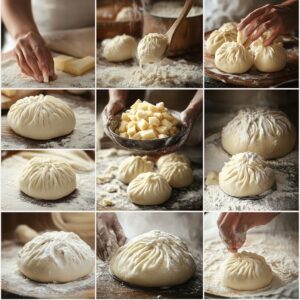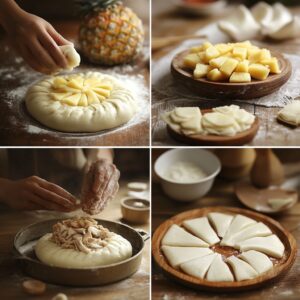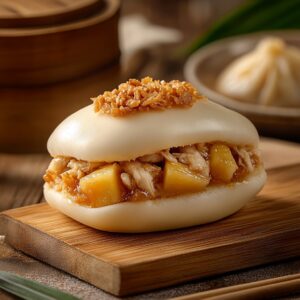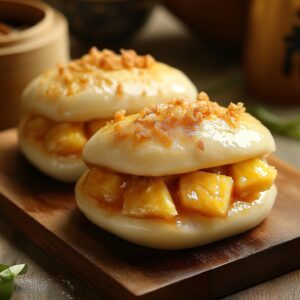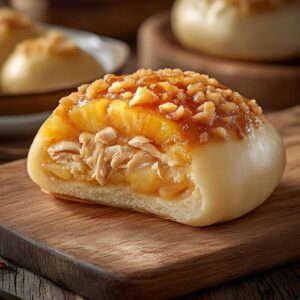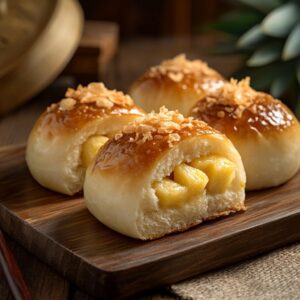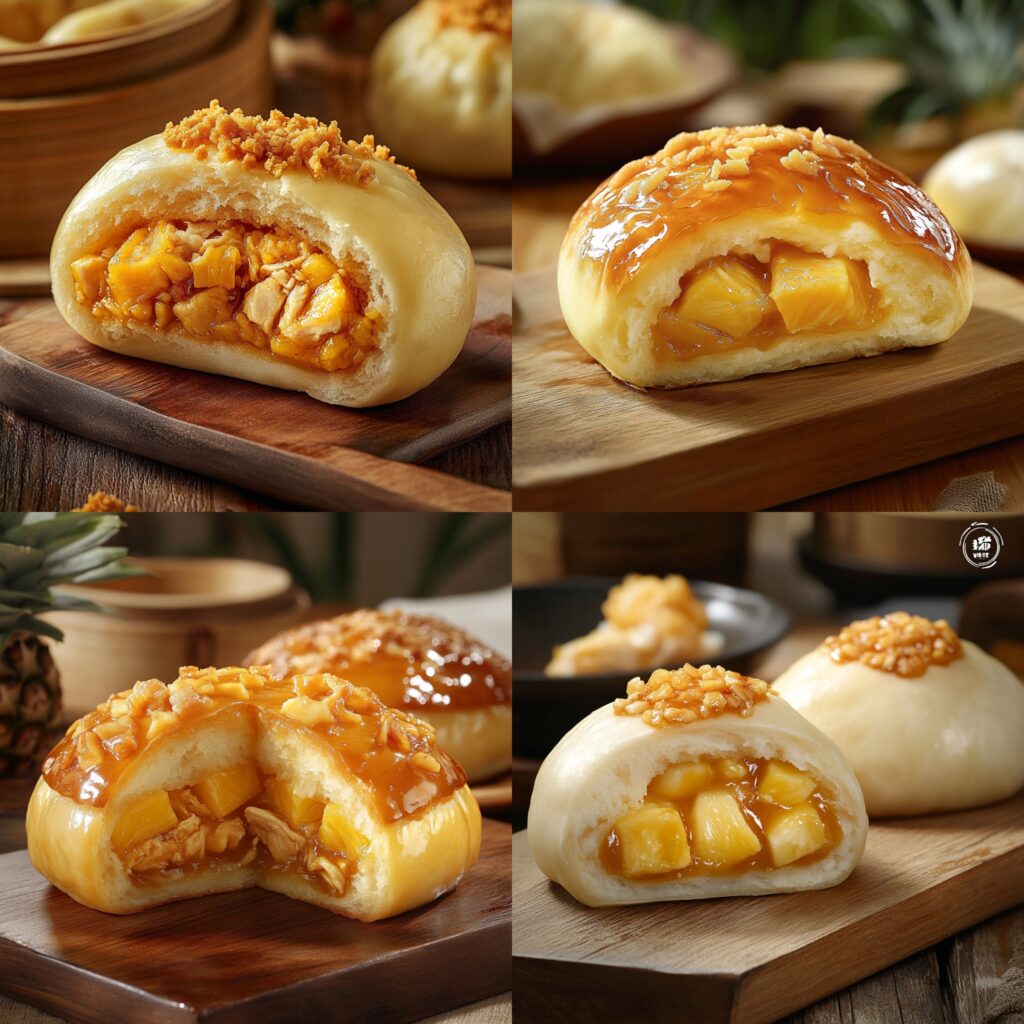Gai Mei Bao Recipe, or “Chicken Pineapple Bun,” is a well-loved treasure of Cantonese Cuisine. This part of dim sum is famous, not only in Hong Kong, but within the wider diaspora of Chinese communities. This bun is particularly appealing due to its distinctive, fluffy, soft texture as well as its crunchy, sweet, golden top. The bun is both sweet and savory, making it a delightful snack for breakfast or “tea time”.
As for the recipe of Gai Mei Bao, it incorporates soft, tender cuts of chicken, a little bit of sweet pineapple, and carefully chosen seasonings to bring everything together. The pineapple-shaped sweet and crunchy topping, while Chinese in origin, gives it a globally appealing touch. The bun has its roots in Chinese culture, but people from all over the world enjoy the mix of sweet and savory flavors.
Forming the Gai Mei Bao requires a perfect blend of skill and the right materials. Each part of the recipe, from the soft and fluffy dough to the preparation of the dough, adds to the experience of this savory and sweet treat. Every person, no matter if they are a professional or a novice, will be able to enjoy this simple recipe, which is a treat on the side of the streets of Canton.
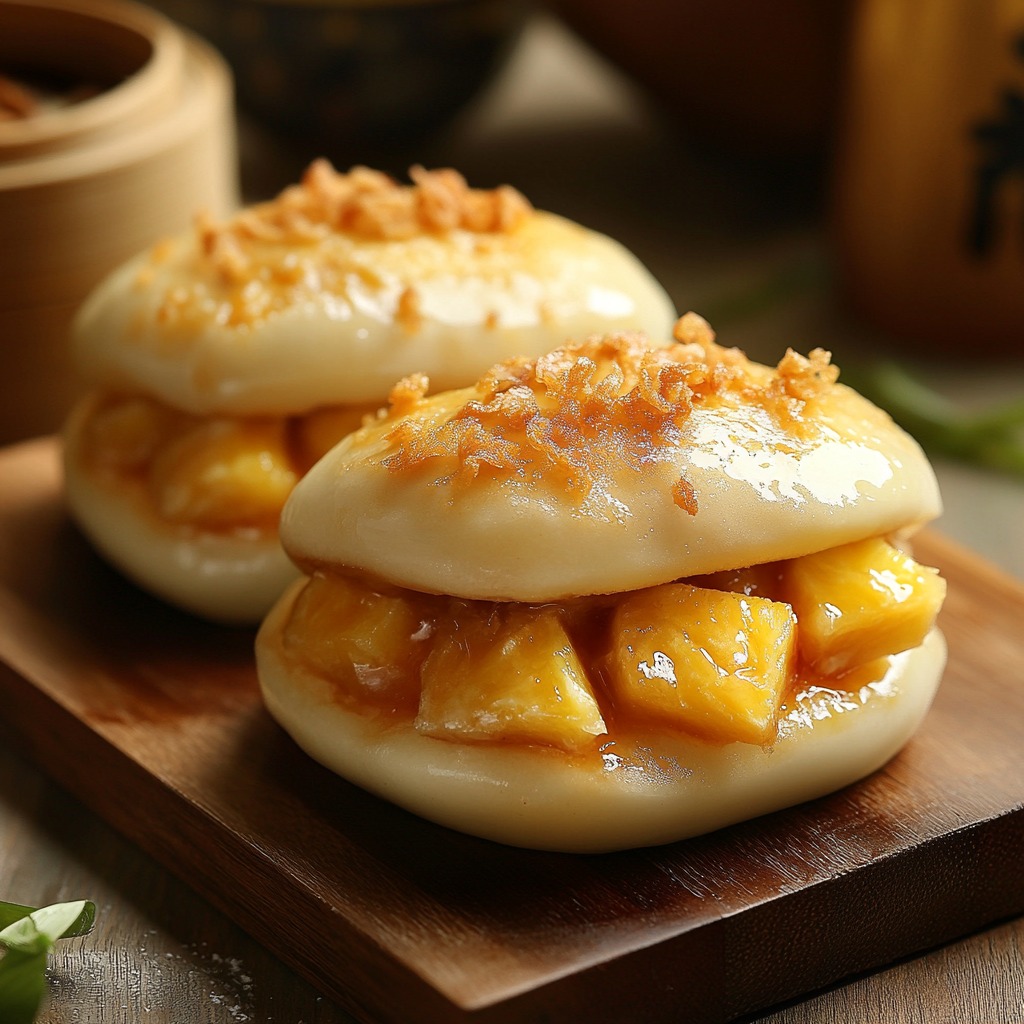
- What is Gai Mei Bao Recipe? A Traditional Chinese Delight
- Ingredients for the Perfect Gai Mei Bao Recipe
- Step-by-Step Guide to Preparing Gai Mei Bao Recipe
- Preparing the Bun Dough
- Assembling and Baking Gai Mei Bao Recipe
- Serving and Enjoying Gai Mei Bao Recipe
- The Ingredients and Methods that Make Gai Mei Bao's Texture Perfect: Its Fluffiness and Softness
- Gai Mei Bao for Beginners: Making This Dim Sum Favorite with Gai Mei Bao
- Gai Mei Bao Around the World: How Different Cultures Have Put Their Spin on This Classic
- The Best Pairings for Gai Mei Bao: Drinks and Sides to Complement Your Meal
- Gai Mei Bao: An Introductory Guide Towards Steam Bun Dim Sums at Home
- Gai Mei Bao: The Dish That Represents Hong Kong's Bakeries
- Why Gai Mei Bao Is A Treat And A Center Piece For Dim Sum
- Cultural Importance of Gai Mei Bao During Chinese Festivities and Celebrations
- Gai Mei Bao and Other Chinese Buns: What is Different
- Perfecting Gai Mei Bao: Advanced Techniques for Seasoned Cooks
- The Rise of Gai Mei Bao in the Vegan and Plant-Based World
- Gai Mei Bao: Prepare It As Breakfast, Lunch, or Dinner
- Gai Mei Bao: An Attractive and Tasty Bun for Special Occasions
- Conclusion
- FAQs:
- Share Your Twist
What is Gai Mei Bao Recipe? A Traditional Chinese Delight
Gai Mei Bao Recipe, often called”the Chicken Pineapple Bun, is an iconic dish of Cantonese food that has won hearts across the globe. The bun is known for its soft and fluffy texture. This bun is decorated with a distinctive, sweet, and crunchy crust that is reminiscent of the shape of the pineapple. However, the name is a reference to the appearance of the crust; however, the real appeal is in the flavor combination of the spicy chicken filling and the subtle sweet crust. If you like it for dim sum or for an afternoon snack, Gai Mei Baio is a delight that’s bound to delight your palate.
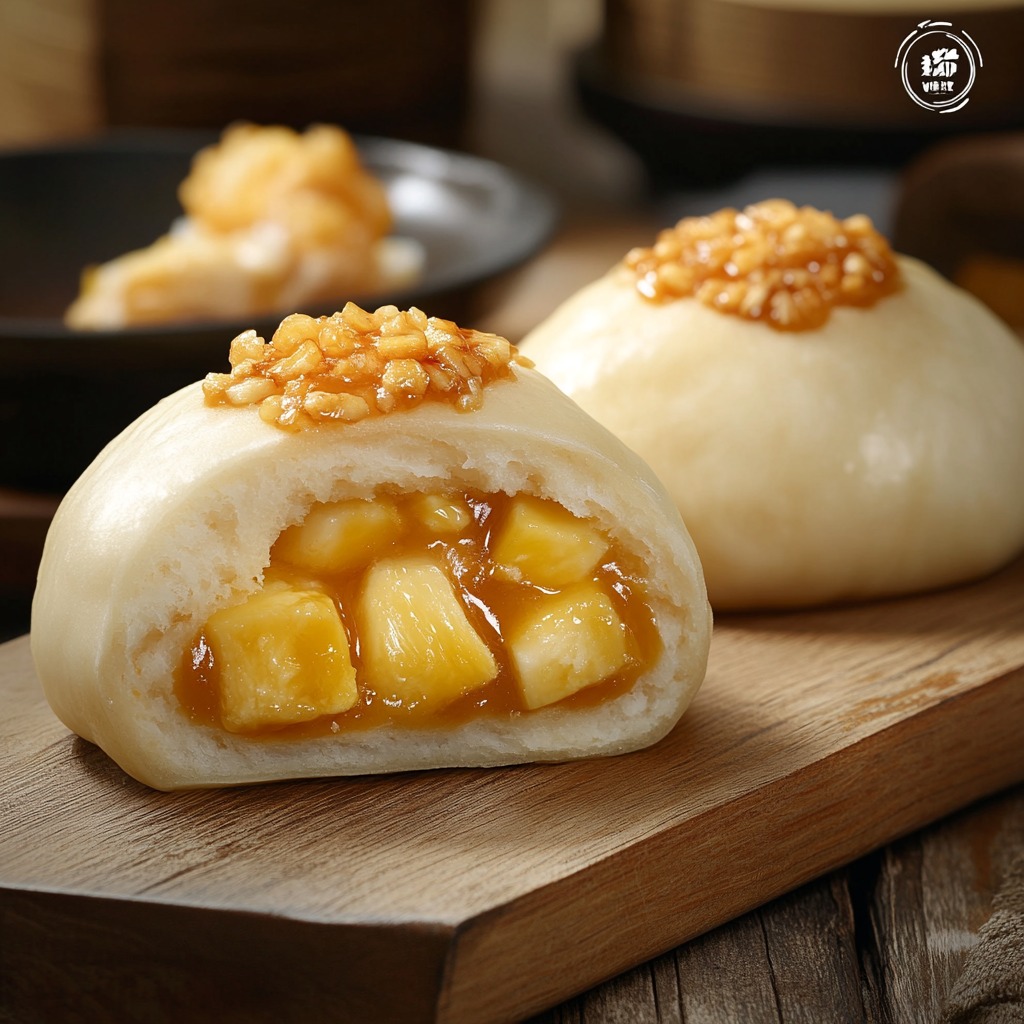
Exploring the History of Gai Mei Bao: From Cantonese Origins to Global Popularity
Gai Mei Bao, commonly called Gai Mei Bao Recipe, also known as Chicken Pineapple Bun, has its roots deeply rooted in Cantonese food culture. The origins of this particular food date back to the beginning of the 20th century, the time it was brought to Hong Kong as part of the growing dim sum tradition. In the past, it has grown into an iconic snack in Chinese communities across the globe. Discover the fascinating background and significance of the culture behind Gai Mei Bao Recipe and how it was introduced from local bakeries to global recognition.
Ingredients for the Perfect Gai Mei Bao Recipe
To make the ideal Gai Mei Bao Recipe, you’ll need a few key ingredients for both the filling and the signature sweet crust topping. Below are the main ingredients you’ll need to gather:
For the Bun Dough:
- All-purpose flour
- Sugar
- Yeast
- Warm water
- Milk powder
- Salt
- Butter or oil
For the Chicken Filling:
- Boneless chicken breast or thigh (diced or shredded)
- Pineapple (diced)
- Soy sauce
- Oyster sauce
- Ginger and garlic (minced)
- Salt and pepper to taste
For the Pineapple Crust:
A pinch of salt
Butter
Sugar
Egg yolk
Flour
Baking powder
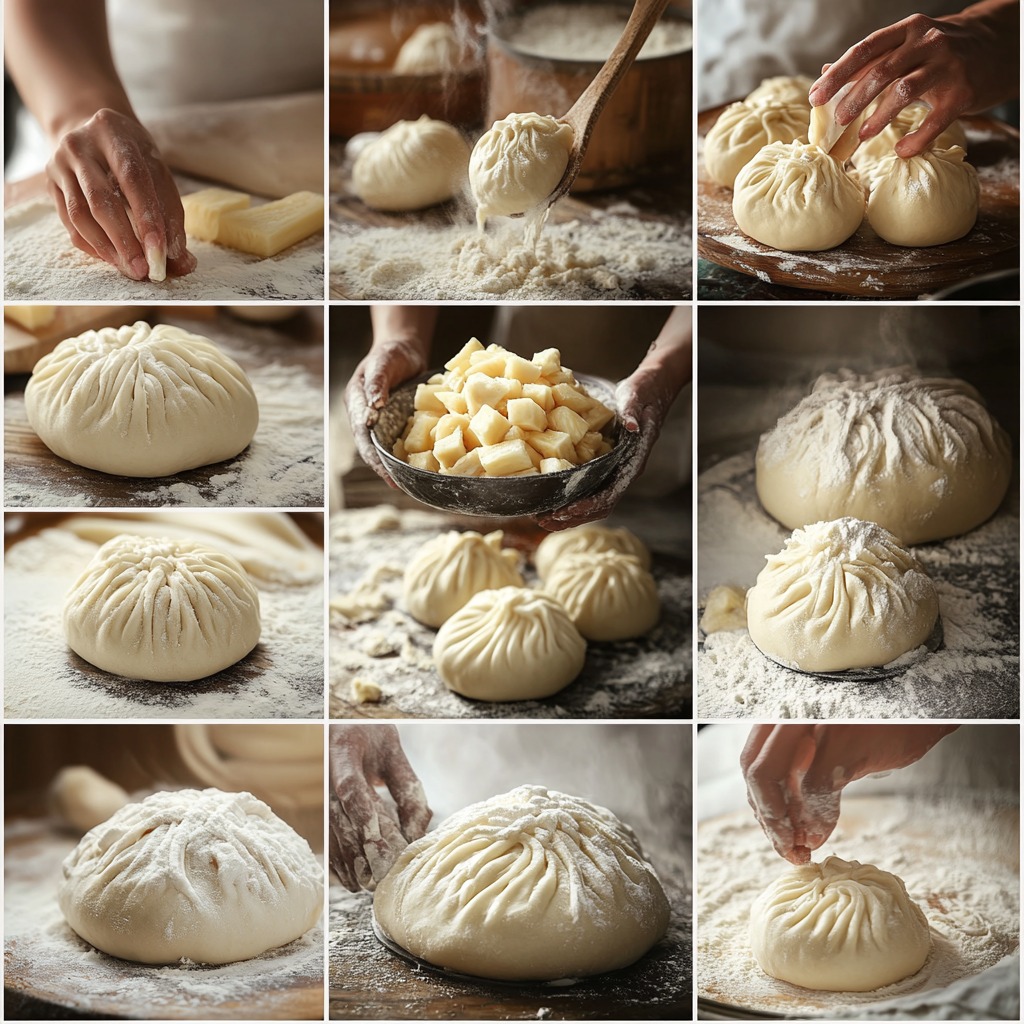
Step-by-Step Guide to Preparing Gai Mei Bao Recipe
Preparing the Bun Dough
- Activate the Yeast: Start by activating the yeast in warm water with a bit of sugar. Let it sit for 5-10 minutes until it becomes frothy.
- Mixing the Dough: In a large mixing bowl, combine the flour, sugar, milk powder, salt, and activated yeast. Gradually add water to form a soft dough.
- Kneading the Dough: Knead the dough on a floured surface until it’s smooth and elastic. Cover it with a damp cloth and let it rise for 1-2 hours or until it doubles in size.
Making the Chicken Pineapple Filling
- Cook the Chicken: In a pan, sauté minced ginger and garlic in oil until fragrant. Add diced chicken and cook until browned season with soy sauce, oyster sauce, salt, and pepper.
- Add Pineapple: Stir in diced pineapple and cook for a few more minutes until the filling is combined and fragrant. Remove from the heat and let it cool.
Preparing the Pineapple Crust Topping
Shape the Topping: Roll the topping dough into small balls. Using your hands, flatten each ball into a round shape that will sit on top of the bun dough.
Making the Crust: In a bowl, cream together softened butter and sugar. Add the egg yolk, flour, baking powder, and a pinch of salt. Mix to form a thick dough.
Assembling and Baking Gai Mei Bao Recipe
Shaping the Buns
- Divide the Dough: Once the bun dough has risen, punch it down and divide it into small portions (around 10-12). Flatten each piece with your hands to form a round disc.
- Add the Filling: Place a spoonful of the chicken pineapple filling in the center of each disc. Pinch the edges of the dough together to seal the filling inside, forming a bun shape.
Adding the Topping
- Apply the Pineapple Crust: Gently press the pineapple crust topping onto the top of each bun. Use a fork or knife to create a decorative crosshatch pattern if desired.
Baking the Buns
Bake: Place the buns on a baking tray lined with parchment paper and bake for 15-20 minutes or until golden brown. The topping should be crisp, and the buns should have a light, airy texture.
Preheat the Oven: Preheat your oven to 350°F (175°C).
Serving and Enjoying Gai Mei Bao Recipe
After baking, Gai Mei Bao Recipe is ideal to serve warm. The fluffy, soft bun, paired with the delicious pork and sweet topping of pineapple, makes an unbeatable taste profile. They are great to snack on, as breakfast, or as a part of an overall dim sum buffet. They are great as a stand-alone treat or with tea to make a full experience. If you’re hosting the dim sum brunch of your choice or simply want to enjoy a delicious homemade dessert, Gai Bao is bound to please your friends and family!
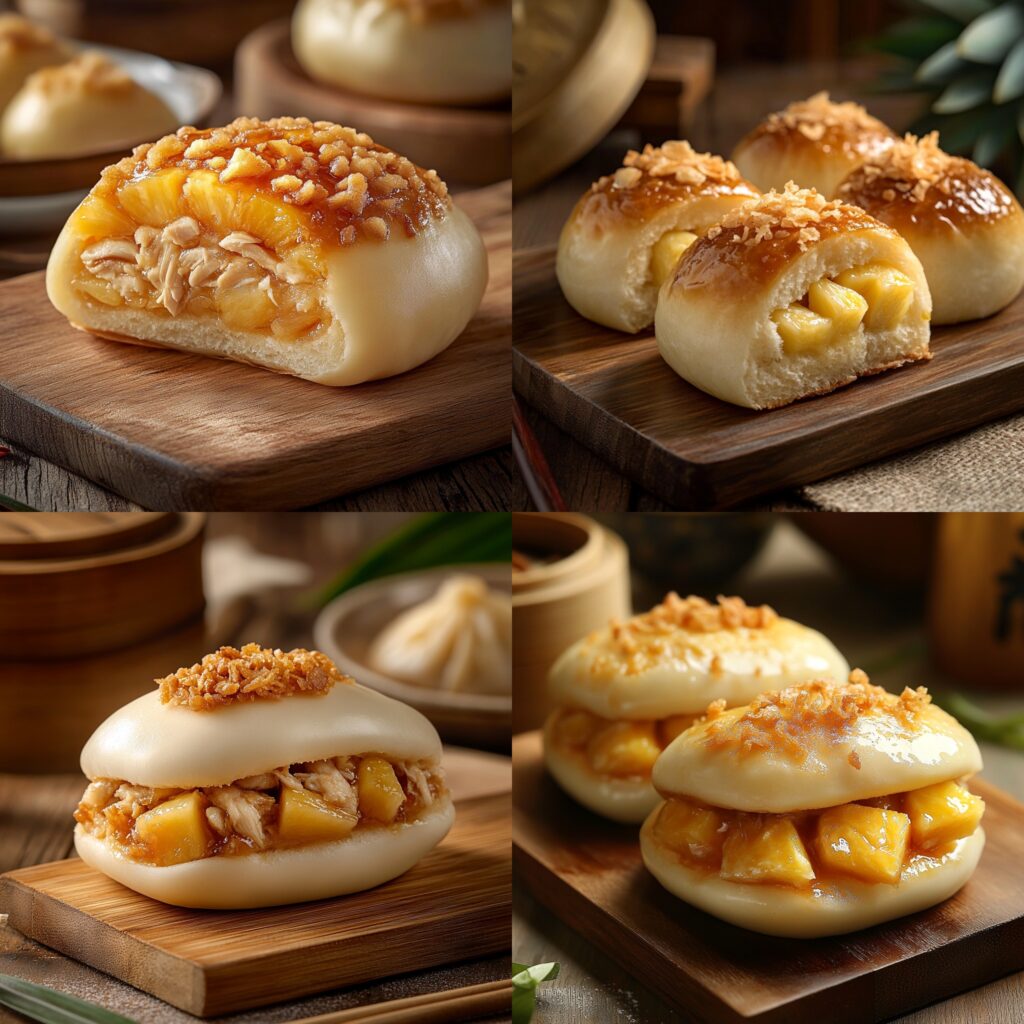
The Ingredients and Methods that Make Gai Mei Bao’s Texture Perfect: Its Fluffiness and Softness
Along with hot Gai Mei Bao, Gai Mei Bao’s texture, ever so gentle, is downright irresistible. To achieve the desired soft lightness and fluffiness, specific baking techniques and methods must be utilized. Fluffiness and lightness are achieved through the technique of using dough, the right blend of ingredients, precise temperatures, along proper yeast activation. Discover the different stages of baking and the important steps needed to achieve perfect texture, including activation of yeast and proofing. Uncover the steps that will aid in baking the ideal buns always.
Exploring the Classic Gai Mei Bao Recipe: Its Customization
The timeless Gai Mei Bao’s savory chicken and pineapple filling is well known, but this dish can be customized to suit different personal tastes. Alternatives such as BBQ pork, tofu or mushroom vegetarian variants, and even red bean paste can be redone to suit individual tastes. Not only can fillings be customized, but also crust and cover toppings, where the traditional Gai Mei Bao can be matched with chocolate or even matcha for a different feel. This distinct dish can be adapted to be more personalized through filling and crust cover.
Gai Mei Bao as a Dim Sum Delight: A Staple in Cantonese Dishes
Gai Mei Bao is especially vital in the context of Cantonese dim sum since its dim sum culture is the most perfect symbol of gastronomy, as Gai Mei Bao Recipe participates in this rich tradition food. On this article, I would like to present the importance of Gai Mei Bao in the context of dim sum and some of the cultural practices around the dim sum meal, the variety of food that is served in combination with Gai Mei Bao and the reasons for this buns being not only a local but a tourist favorite in Hong Kong.
The Impact of Pineapple on Nutrition and Taste in Gai Mei Bao
Chicken and pineapple together in Gai Mei Bao is a delightful mixture of flavors that offers some noteworthy health advantages, too. Pineapple is widely recognized for being a good source of vitamin C. In addition, it is rich in antioxidants and aids in digestion. Learn how pineapple’s sweet and tangy flavor blends harmoniously with chicken while also adding nutritional value. Discover the secret for fully utilizing pineapple’s Gai Mei Bao’s health benefits and flavor.
Gai Mei Bao for Beginners: Making This Dim Sum Favorite with Gai Mei Bao
The process of preparing Gai Mei Bao might feel overwhelming for some, but it is achievable with the right tips. This guide is the first step if you lack experience in preparing dim sum. This guide ranges from properly kneading the dough to bun assembly and the wonderful golden-brown topping, offering tips that are sure to make trying Gai Mei Bao for the first time remarkable.
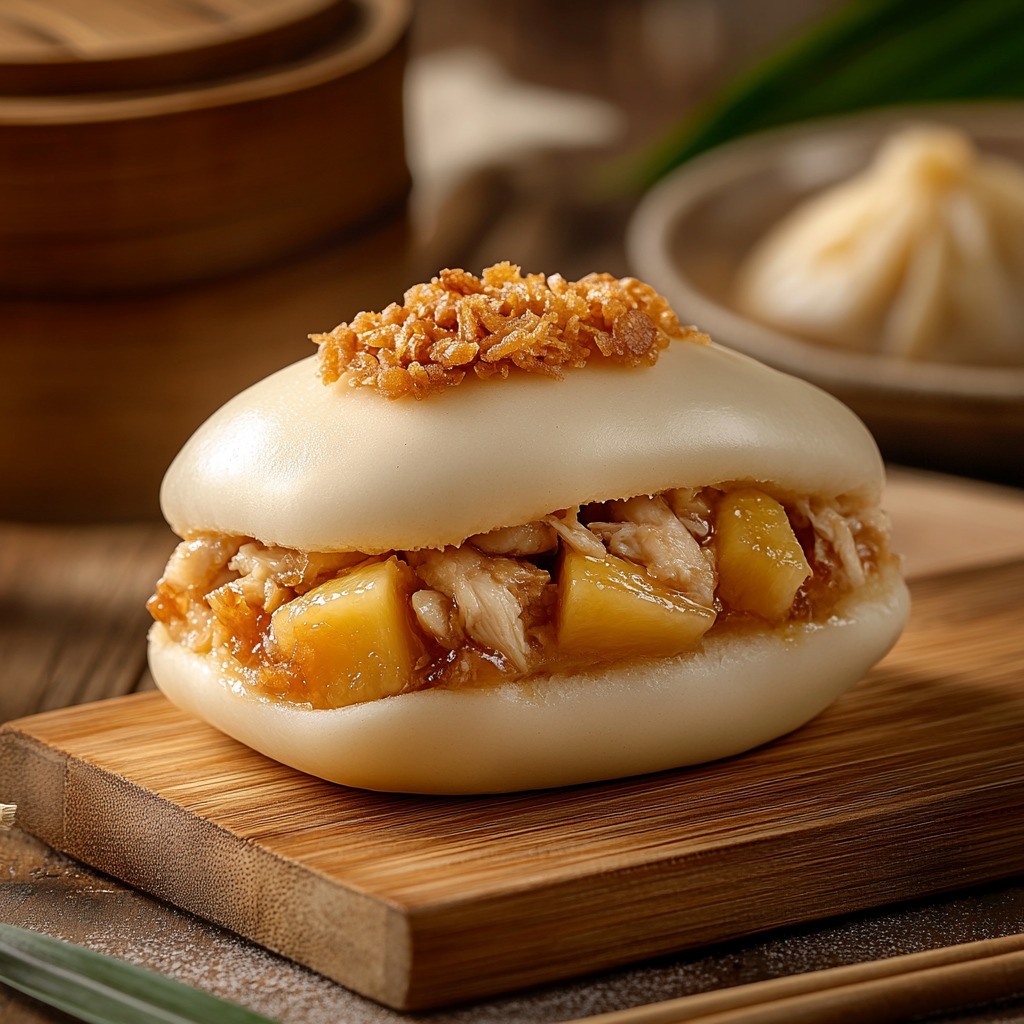
Gai Mei Bao Around the World: How Different Cultures Have Put Their Spin on This Classic
The popularity of Gai Mei Bao goes far beyond Hong Kong. This traditional bun has been adopted and adapted in places such as Taiwan, Malaysia, and even North America. Gai Mei Bao’s variations include the addition of distinct fillings and regional spices, along with the unique styles of serving it. Learning how cultures have uniquely customized Gai Mei Bao as it traveled brings out the wonder of culinary creativity.
The Best Pairings for Gai Mei Bao: Drinks and Sides to Complement Your Meal
Like many other dishes, Gai Mei Bao is best enjoyed with the right drinks and side dishes. From breakfast to lunch and even during dim sum gatherings, Gai Mei Bao Recipe can be enjoyed with and is enhanced with the right selection to elevate the experience. Read on to learn about Gai Mei Bao’s best drink and side dish companions, which include various Chinese teas and pickled and sweet soups for a balanced and enjoyable meal.
Gai Mei Bao: An Introductory Guide Towards Steam Bun Dim Sums at Home
Dim sum offers a unique way of sampling numerous dishes, and Gai Mei Bao is a notable steam bun dish in this tradition. For those who wish to recreate the vivid experiences of dim sum in the comfort of their home, this steam bun dish could be a beginner’s guide to the art. Preparation begins by understanding the basic requirements of dim sum skillfully kneading the steam bun dough and fillings, steaming and baking, or skillfully kneading the dough and fillings. Steps to prepare Gai Mei Bao šandwich and a home so dim sums respect the culinary and food culture.
Gai Mei Bao: The Dish That Represents Hong Kong’s Bakeries
Gai Mei Bao’s exquisite taste depicts Hong Kong’s unique culture and remains timeless to this day. These bakeries bring a variety of baked products to their customers, and Gai Mei Bao has risen to the occasion to become a household name. Understand the cultural significance of Gai Mei Bao and why it remains a centerpiece of Hong Kong’s bakeries. Learn how Gai Mei Bao is regarded as a representation of the city’s culinary transformation over the years. Learn also how the incorporation of modern twists on the recipe has not affected the traditional baked dish’s essence.
Why Gai Mei Bao Is A Treat And A Center Piece For Dim Sum
Any dim sum enthusiast should start with Gai Mei Bao. The dish features a blend of soft bread, a mixture of spices, a savory filling, and a crunchy topping. Discover the history of Gai Mei Bao and why it is considered the crown jewel and the most delectable part of dim sum. Find out the reasons as to why Gai Mei Bao has helped elevate the dim sum with the combine of its addictive taste and the dish’s elevation to a whole new level.
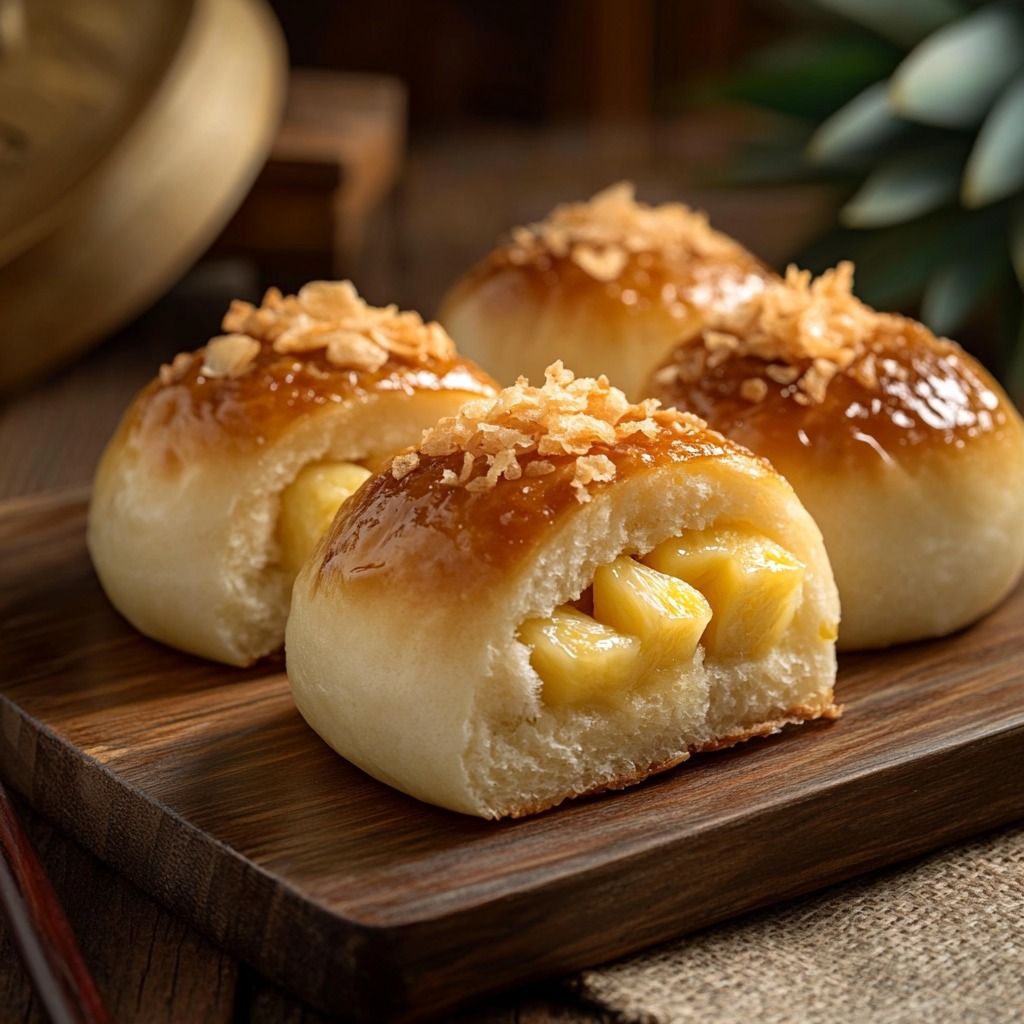
Cultural Importance of Gai Mei Bao During Chinese Festivities and Celebrations
As a cherished Chinese dish, gai mei bao is enjoyed during everyday meals and has a significant role during Chinese festivals and celebrations. Learn how these buns became associated with family gatherings, holiday meals, and even celebrations like the Chinese New Year. Understand what family bonding and the bun’s sweet and savory flavor combination signify during the festivities and their importance in the Chinese culture.
Gai Mei Bao and Other Chinese Buns: What is Different
The world of Chinese buns is complex, with offerings such as char siu bao and baozi, which are steamed buns with various fillings. Gai mei bao Recipe is different and more distinct than the other Chinese buns since its flavor and texture make it more unique. In this comparison, explore other widely loved buns and differentiate gai mei bao’s distinct attributes. Understand more about the cherished gai mei bao through the unique ways of its preparation, ingredients, and the eating experience.
The pineapple topping of Gai Mei Bao is not only eye-catching but also one of a kind in terms of its texture and feel. It is a blend of both tradition and creativity, which makes it one of a kind in Chinese bakery culture. Everything has a story. In this case, we will be talking about the story behind the pineapple-laden crust and its rising fame. It is a perfect blend of creativity and the symbolic nature of culinary tradition, and it is splendid in its fusion.
A Gai Mei Bao, which is a part of the Cantonese cuisine, has grown in popularity and is not only bound to the Hong Kong region. Modern Asian Fusion cuisine has seen the rise of Gai Mei Bao as it has become one of the most delectable and preferred dishes. It has allowed chefs to put a spin on traditional dishes in a contemporary manner. Read how this dish has been adapted in restaurants and is rapidly innovating across the globe with new toppings, fillings, and unique baking styles that are elevating this dish to new heights.
Perfecting Gai Mei Bao: Advanced Techniques for Seasoned Cooks
If you have a good grasp of order cooking skills and are looking to take Gai Mei Bao to the next level, you are in the right place. There are features and tips available that should make the dish even better. Learn how to professionally mold the dough, achieve a desired filling balance, and master the pineapple topping. Familiarize yourself with the items and tools that could help you achieve a pro Gai Mei Bao level.
The Rise of Gai Mei Bao in the Vegan and Plant-Based World
With the shift to more Vegan diets, a need for plant-based Gai Mei Bao has emerged, and thus a new challenge for everyday cooks. Explore how one of the favorite Gai Mei Bao can be made to fit a vegan lifestyle by incorporating plant-based fillers and replacing traditional staples with non-animal alternatives. Understand the essence and the concept of Gai Mei Bao by exploring the process and the idea of veganizing the dish, and learn some of the new ideas revolving around the dish in the vegan and plant-based world.
Gai Mei Bao: Prepare It As Breakfast, Lunch, or Dinner
Gai Mei Bao is most popularly eaten during dim sum; however, it is best suited as a dish to be eaten during any part of the day. In this article, we discuss how best to serve Gai Mei Bao for breakfast, lunch, and dinner. From being part of a light breakfast, a flavorful dinner side, to being served with a hearty soup, Gai Mei Bao is best served with a variety of dishes.
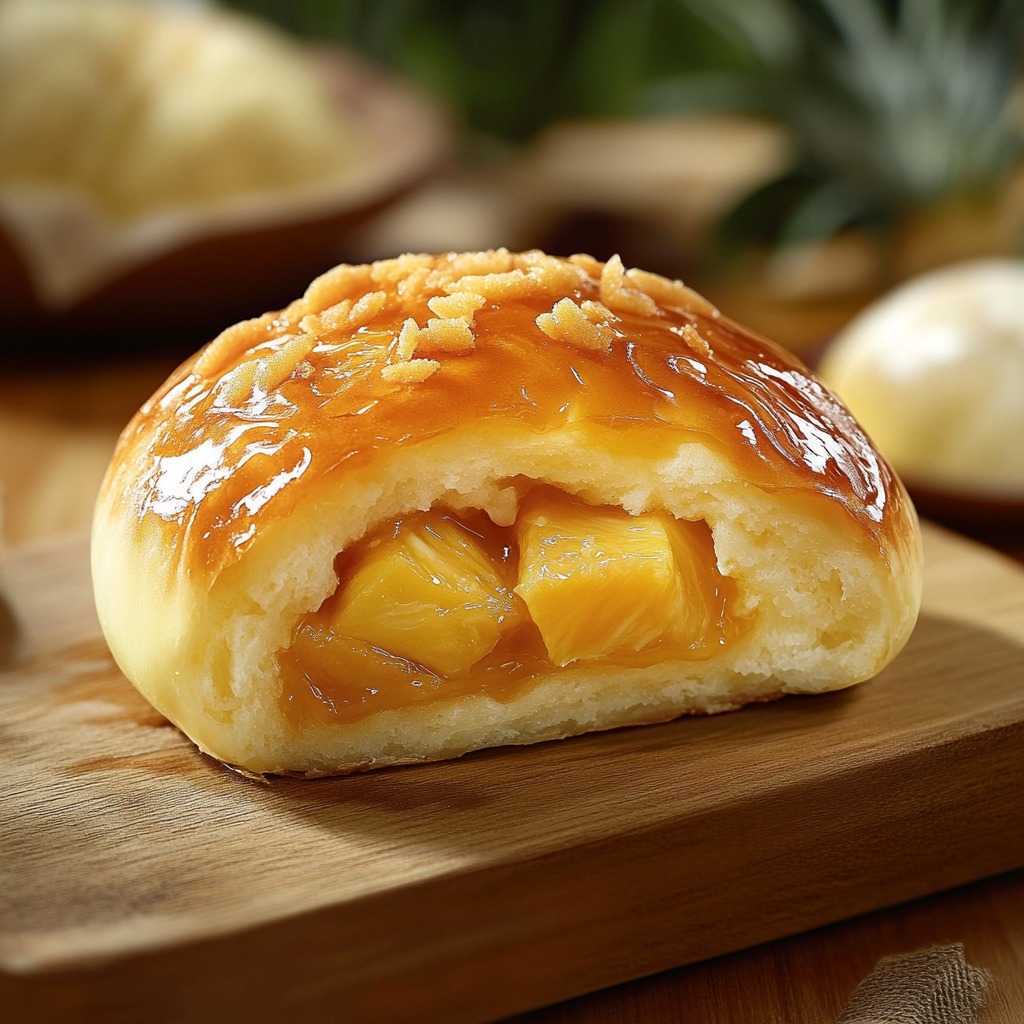
Gai Mei Bao: An Attractive and Tasty Bun for Special Occasions
Gai Mei Bao can be served creatively during parties, wedding ceremonies, and even during holiday gatherings. In this article, we show how best to serve these delightful buns to match and enhance the theme of the event. From presentation as mini appetizers or tailoring the fillings to a particular cuisine, or served as elegant Gai Mei Bao to impress the guests. Special occasions are made even more memorable with the beauty and flavor of Gai Mei Bao.
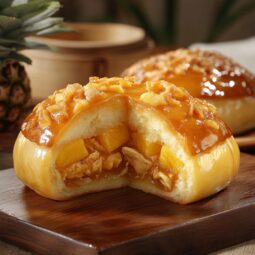
Gai Mei Bao (Chicken Pineapple Bun)
Equipment
- Large mixing bowls
- Stand mixer or hand mixer (optional)
- Rolling Pin
- Baking sheet
- Parchment paper
- Small bowls for preparing toppings
- Oven
Ingredients
- For the Bun Dough:
- 3 cups all-purpose flour
- 1 packet active dry yeast about 2 ¼ teaspoons
- ¼ cup sugar
- 2 tablespoons milk powder
- 1 teaspoon salt
- 2 tablespoons butter softened
- 1 cup warm water about 110°F
- 1 tablespoon vegetable oil for greasing
- For the Chicken Pineapple Filling:
- 1 lb boneless chicken breast or thigh diced
- ½ cup fresh pineapple diced
- 2 tablespoons soy sauce
- 1 tablespoon oyster sauce
- 1 teaspoon minced garlic
- 1 teaspoon minced ginger
- Salt and pepper to taste
- For the Pineapple Crust Topping:
- ½ cup butter softened
- ½ cup sugar
- 1 egg yolk
- 1 ¼ cups all-purpose flour
- 1 teaspoon baking powder
Instructions
- Make the dough: Mix yeast with warm water and let it foam. Add flour, sugar, and salt, then knead until smooth. Let it rise for 1-2 hours.

- Make the filling: Cook chicken with garlic, ginger, soy sauce, and pineapple until well combined. Let it cool.

- Prepare the topping: Mix butter, sugar, egg yolk, flour, and baking powder into a dough. Roll into small balls.

- Assemble the buns: Flatten dough, add the filling, seal the bun, and top with the pineapple crust.

- Bake: Preheat the oven to 350°F (175°C) and bake for 15-20 minutes until golden.

- Serve: Let cool slightly and enjoy.

Notes
- Customizations: Feel free to experiment with different fillings like BBQ pork, vegetables, or sweet red bean paste.
- Vegan Option: Substitute the chicken with plant-based protein, like tofu or tempeh, and use a dairy-free butter for the topping.
- Storage: Gai Mei Bao is best enjoyed fresh but can be stored in an airtight container for up to 2-3 days. To reheat, simply steam or microwave for a few seconds.
- Topping Variations: You can add a little matcha or cocoa powder to the topping dough for a unique twist in flavor and color.

Conclusion
Exemplifying the epitome of Cantonese baked delicacies, Gai Mei Bao features the perfect combination of soft, fluffy dough, filling of chicken with pineapple, and the sweet and crunchy topping. This dish is not only famous regionally but is also consumed globally as a snack. Gai Mei Bao is not only relished at a dim sum table, but is also served as a modern dish in fusion cuisine.
The versatility of Gai Mei Bao Gai allows for the tampering in customization of toppings and fillings to be made. Although the traditional filling of chicken and pineapple remains the most popular, the options to modify are infinite. If you are looking to prepare a vegan Gai Mei Bao or change the filling to something different, you are encouraged to be inventive. This tender delicacy maintains the ability to change with modern culinary trends, while in the same breath keeping its roots close, and for that reason, Gai Mei Bao will always remain a classic.
In summation, Gai Mei Bao represents more than a dish; it serves as a cultural bond that unites people around shared culinary preferences. As a dish, it has traveled from the bakeries in Hong Kong to attain global acclaim, which exemplifies the widespread love for unpretentious yet delightful food. Gai Mei Bao imparts an indelible mark, especially for the first-timers, while forever enchanting seasoned dim sum lovers. It presents a blend of tradition and modernity in each bite, which can be savored.
FAQs:
Frequently Asked Questions (FAQs)
What is Gai Mei Bao?
Gai Mei Bao, also known as Chicken Pineapple Bun, is a popular Cantonese treat made from fluffy, soft dough filled with savory chicken and pineapple. It is topped with a sweet, crunchy pineapple-like crust.
Can I use a different filling for Gai Mei Bao?
Yes! You can experiment with various fillings, such as BBQ pork, mushrooms, or tofu for a vegetarian version. The possibilities are endless!
How do I store leftover Gai Mei Bao?
Store Gai Mei Bao in an airtight container at room temperature for up to 2 days. For longer storage, refrigerate them for up to 4 days or freeze for up to 1 month.
Can I make Gai Mei Bao gluten-free?
Yes, you can make gluten-free Gai Mei Bao by using gluten-free flour and ensuring all other ingredients are suitable for a gluten-free diet.
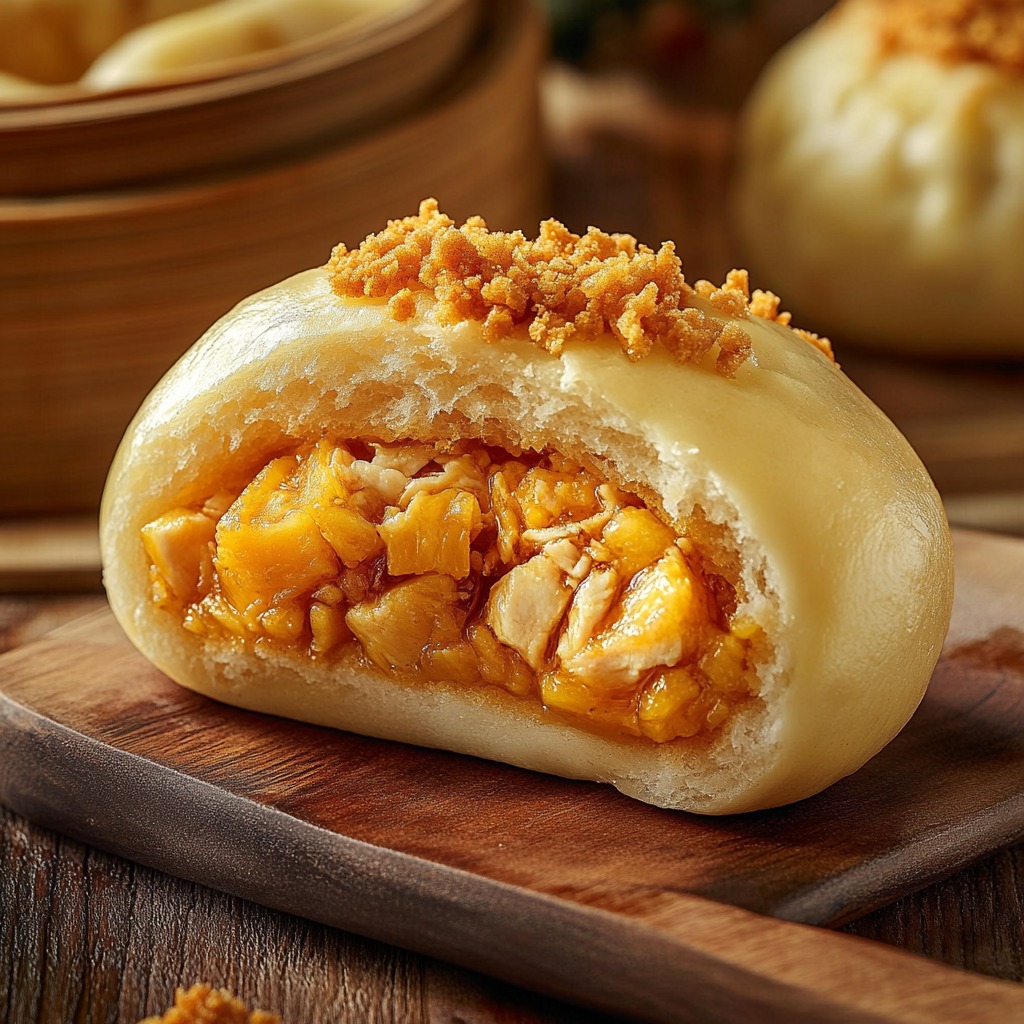
Share Your Twist
If you’ve added your spin to the classic Gai Mei Bao, we’d love to hear about it! Whether it’s a creative twist on the filling, a new topping, or even a completely different flavor combination, your twist could inspire others to experiment with this beloved dish.
Here’s how you can share your version:
- Include Your Custom Fillings: Perhaps you’ve swapped the traditional chicken and pineapple with pork, shrimp, or even a vegetarian option like mushrooms and tofu. Whatever your choice, feel free to share!
- Change the Topping: Maybe you’ve added matcha powder to the topping for a green tea flavor, or even tried something like a sweet red bean paste topping. Let us know how it turned out!
- Alternative Cooking Methods: If you’ve made changes in the cooking process, such as steaming instead of baking, or using a different oven temperature, share your methods for achieving the perfect bun.
- Additional Flavors: Adding new spices, herbs, or sauces could elevate your Gai Mei Bao to new levels. Share any flavor enhancements that have worked for you!
How to Share:
- Post your twist on social media using the hashtag #MyTwistOnGaiMeiBao.
- Leave a comment or share a link to your recipe in the community, where others can try it and enjoy!
References :
Meet Mantou: The Bread Behind the Bao Bun

